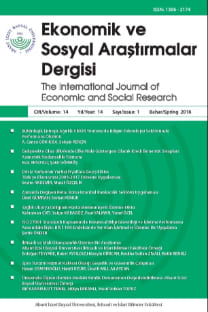NEXUS BETWEEN FOREIGN BANKS AND FINANCIAL INCLUSION: EVIDENCE FROM THE TRANSITION ECONOMIES
This paper examines empirically the impact of foreign banks on access and use of financial services for a panel of transition economies over the period 2004-2017. Transition economies provide rich evidence for analyzing this relationship given the predominance of foreign banks in their banking systems. The results reveal that foreign bank presence is positively associated with banking sector outreach indicators, such as ATM and branch penetration, after controlling for several macroeconomic, institutional and financial country-specific factors, however foreign bank entry is found to have no impact on the use of financial services, as measured by borrowing per capita. Results from low and high foreign bank threshold subsamples provide further evidence that foreign bank penetration effects on financial inclusion do not vary by thresholds.
Anahtar Kelimeler:
foreign banks, financial inclusion, banking sector outreach, transition economies
___
- Arellano, M. & Bond, S. (1991). Some Tests of Specification for Panel Data: Monte Carlo Evidence and an Application to Employment Equations. The Review of Economic Studies, 58(2), 277–297. Arellano, M. & Bover, O. (1995). Another Look at the Instrumental Variable Estimation of Error-Components Models. Journal of Econometrics, 68(1), 29–51.Beck, T., Demirguc-Kunt, A. & Martinez- Peria, M. S. (2007). Reaching Out: Access to and Use of Banking Services Across Countries. Journal of Financial Economics, 85(1), 234–266.
- Beck, T. & Martinez –Peria, M.S. (2010). Foreign Bank Participation and Outreach: Evidence from Mexico. Journal of Financial Intermediation, 19(1), 52–73.
- Claessens, S. & Van Horen, N. (2014). Foreign Banks: Trends and Impact. Journal of Money, Credit and Banking, 46(1), 295–326.
- Claessens, S. & Van Horen, N. (2015). The Impact of the Global Financial Crisis on Banking Globalization. DNB WP No. 459.
- Cull, R. & Martinez-Peria, M.S. (2013). Bank Ownership and Lending Patterns During the 2008-2009 Financial Crisis: Evidence from Latin America and Eastern Europe. Journal of Banking and Finance, 37(12), 4861–4878.
- De Haas, R. & Van Lelyveld, I. (2006). Foreign Banks and Credit Stability in Central and Eastern Europe. A Panel Data Analysis. Journal of Financial Intermediation, 30(7), 1927–1952.
- De la Torre A, Martinez Pería, M.S. & Schmukler, S. L. (2010). Bank Involvement with SMEs: Beyond Relationship Lending. Journal of Banking & Finance, 34, 2280–2293.
- Dell’Ariccia, G. & Marquez, R. (2004). Information and Bank Credit Allocation. Journal of Financial Economics, 72(1), 185-214.
- Detragiache E., Tressel, T. & Gupta, P. (2008). Foreign Banks in Poor Countries: Theory and Evidence. The Journal of Finance, 63(5), 2123–2160.
- Gormley, T.A. (2010). The Impact of Foreign Bank Entry in Emerging Markets: Evidence from India. Journal of Financial Intermediation, 19(1), 26–51.
- Ellis, K. (2007). Is Financial Liberalisation Enough to Promote Financial Inclusion?”Overseas Development Institute Brief 82, June.
- Gopalan, S. & Rajan, R. S. (2018). Foreign Banks and Financial Inclusion in Emerging and Developing Economies: An Empirical Investigation. Journal of International Development, 30, 559–583. Hausman, J. A. (1978). Specification Tests in Econometrics. Econometrica, 46, 1251-1271. Naaborg, I. Scholtens, B., De Haan, J. Bol, H. & De Haas, R. (2003). How Important are Foreign Banks in the Financial Development of European Transition Countries?, CESifo Working Paper Series 1100, CESifo Group Munich.
- Sengupta, R. (2007). Foreign Entry and Bank Competition. Journal of Financial Economics, 84(2), 502-528.
- Stiglitz, J. (2005). Finance for Development. In: Ayogu, M. and Ross, D. (Eds.): Development Dilemmas: The Methods and Political Ethics of Growth Policy (pp.13-25). Routledge, Taylor & Francis Inc., Great Britain,
- ISSN: 1306-2174
- Yayın Aralığı: Yılda 2 Sayı
- Başlangıç: 2005
- Yayıncı: Abant İzzet Baysal Üniversitesi İktisadi ve İdari Bilimler Fakültesi
Sayıdaki Diğer Makaleler
Yalçın KARAGÖZ, Hakan Tahiri MUTLU, Saniye SAĞIR, Mümine CELİL
HİZMET KALİTESİ ve PROMOSYON KAMPANYALARI MÜŞTERİ TATMİNİ VE MARKA SADAKATİ İÇİN YETERLİ MİDİR?
YABANCI BANKALAR VE FİNANSAL İÇERME ARASINDAKİ İLİŞKİ: GEÇİŞ EKONOMİLERİ ÖRNEĞİ
İSTANBUL İLİ ERKEK CİNSİYETİ OTOMOBİL TALEBİ YAPISI VE TÜKETİCİ TERCİHLERİNDE DEĞİŞMELER
Mustafa AKAL, Hilal ALPDOĞAN, Ahmet AKAT
İSTANBUL İLİ OTOMOBİL TALEBİ YAPISI VE TÜKETİCİ TERCİHLERİNDE DEĞİŞMELER
Mustafa AKAL, Hilal ALPDOĞAN, Ahmet AKAT
TÜRKİYE’NİN AVRUPA BİRLİĞİ’NE İHRACATI: ÇEKİM MODELİ ANALİZİ
Helin SARI ERTEM, Sevda KORHAN
NEXUS BETWEEN FOREIGN BANKS AND FINANCIAL INCLUSION: EVIDENCE FROM THE TRANSITION ECONOMIES
